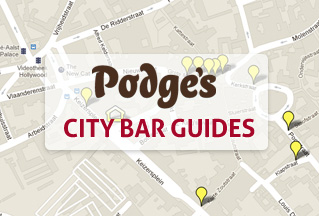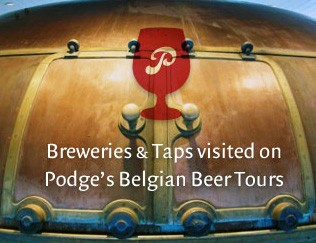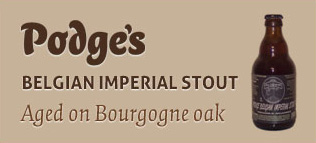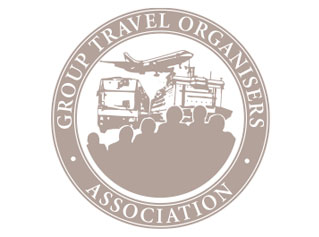Tour 89 / Passchendaele 1917 Centenary Tour
Sunday 29 October – Friday 3 November 2017
This special centenary tour visits the Flanders battlefields. If you are interested in both beer and battlefields this is the tour for you and is guaranteed to be like no other battlefield Tour. We will be exploring the Ypres Salient at the centenary of the Second Battle of Passchenedaele, the last desperate engagement of the Third Battle of Ypres offensive (31 July to 10 November 1917). Your guide will be Podge's partner Siobhan McGinn who is undertaking a PhD in Alcohol, Moral and Discipline in the First World War.
Passchendaele 1917 Centenary Tour detailed itinerary
Day 1 – Sunday 29 October
05.15hr Coach pick up at bus shelter outside Crown House, Crown Street, Ipswich, Suffolk, IP1 3HS (opposite NCP Car Park).
05.45hr Coach pick up Chapel St South Layby Southway, Colchester CO2 7BA.
06.15hr Coach pick up at The Woolpack, Mildmay Road, Chelmsford CM2 0DN.
07.00hr Coach pick up Esso Dartford Service Station, 474 Princes Rd, Dartford DA1 1YT.
07.30hrs Coach pick up Maidstone Service Station, Junction 8, M20 Motorway, Hollingbourne, Maidstone ME17 1SS.
08.00hr Coach pick up at Stop24 J11 M20 near Folkestone Kent CT21 4BL.
09.20hr Eurotunnel Train Crossing from Folkestone.
11.00hr Arrive Calais. We make our way across northern France into Flanders.
12.15hr Our first call is at 't Hellegat Café in Heuvelland for our arranged group lunch and a beer, behind allied lines, close to the front.
14.45hr Leave ‘t Hellegat Café.
14.50hr Arrive at what is now known as De Kinderbrouwerij in Reningelst, a rare First World war survivor then known as the St George (St Joris) Brewery run by M. Six-Colpaert Brewery during WW1 which continued brewing and was used for Divisional Bathing Parties - of which Siobhan will tell us more on tour. Reningelst was just behind allied lines and its estaminets were packed with British and particularly Canadian soldiers during the war. Here we will have a local guide give us a tour* and a tasting* of beer from nearby De Plukker brewery who brew the brown Rooikop beer and the Keikoppenbier blonde, both organic beers made with Belgian hops from Poperinge.
16.20hr Leave Reningelst.
16.30hr Arrive at Halleblast, famously marked on British trench maps as Hellblast to see a rare material survivor of the First World War just behind the British Front line – a tank bridge built by the Royal Engineers from concrete blocks made a Second Army’s concrete factory in Arques, and signed and dated at one end.
17.00hr Arrive at Brandhoek Commonwealth War Graves Commission cemetery (CWGC) to see the most visited soldier’s grave on the Western Front, that of medic Captain Noel Chavasse VC, the only man to be awarded the Victoria Cross and bar in WW1 (double VC).
17.45hr Arrive Vlamertinge New Military Cemetery acting Company Sergeant Major John Kendrick Skinner, VC, DCM who is buried here. We will hear about his war service, and why he is linked to Siobhan’s current PhD research.
18.15hr Arrive at our base for the next five nights Novotel Ieper Centrum Flanders Fields Hotelin Ypres. Evening free in Ypres armed with Evening free in Ypres with Podge’s Ypres Bar Guide and map*.
20.00hr Travellers can take in the moving last post ceremony at the Menin Gate. This is an imposing white memorial gateway inscribed with the names of more than 54,896 men whose have no known grave and who died in the salient up to 16 August 1917. There was not enough room on this gate to record all of the names of the missing so the names of those who were known to have died after that date appear on the panels at Tyne Cot Cemetery, a further 35,000. This site was chosen because of the thousands of men who passed through this spot on their way to the battlefields. It is most famous for the last post ceremony that takes place every evening at 20.00hrs by the Belgian Fire Service. We will arrive in time for those who would like to experience this brief ceremony in this special centenary year. Don’t forget to have a look at the original stone lions which sat at either side of the gate before and during the war and which were presented to Canberra, Australia after the war and which have returned for a visit to coincide with the centenary of the Battle of Third Ypres.
Day 2 – Monday 30 October
11.00hr Later departure time from Hotel by coach. for a visit to the South Salient and a focus on Third Ypres (31 July – 10 November 1917).
11.20hr Arrive at Tyne Cot CWGC the largest Commonwealth war cemetery in the world in terms of burials with 11,961 named soldiers headstones, 8,373 unnamed graves plus 35,000 names engraved on the rear cemetery wall.
12.30hr Leave Tyne Cot CWGC.
12.40hr Arrive Memorial Museum Passchendaele 1917 for a visit*, a museum devoted to the Battle of Third Ypres (31 July – 10 November 1917). The museum has exceptional displays, objects and film explaining fully the battle which raged around this spot in 1917.
15.00hr Arrive at the Volksbond Restaurant opposite the museum in Zonnebeek for our pre-arranged lunch and a beer or two from their superb beer list.
17.30hr Leave Volksbond.
arrive 85th Battalion Nova Scotia Memorial in Passendaelestraat, an obelisk erected to the memory of the 85th Canadian Infantry Batallion (Nova Scotia Highlanders) who fought as part of the British Expeditionary Force, as did the Australians, Canadians, New Zealanders, South Africans and Newfoundlanders. This plaque was erected by the Battalion in memory of their valiant comrades who gave their lives in action before Passchendaele at Decline Copse and Venna Cottage on 28 to 31 October 1917. Below are the names of the 12 officers and 132 other ranks who died in these actions.
Leave 85th Battalion Nova Scotia Memorial Passendaelestraat.
Make our way to Crest Farm Canadian Memorial which marks the place where the men of the Canadian Corps, commanded by General Arthur Currie, finally took possession of the high ground at Crest Farm after ferocious fighting in the Second Battle of Passchendaele between 26th October and 10th November 1917. The Canadian Corps comprised the Canadian 1st, 2nd, 3rd and 4th Divisions. The cost in casualties of the final victory by the end of the battle was very high, with approximately 4,000 men being killed, 7,700 men being wounded, and over 1,000 men suffering from being gassed but not fatally injured. The Canadians were considered crack troops by this point in the war and took over from the exhausted Australian Forces who also lost heavily here.
Leave Canadian Crest Farm Memorial and return the short distance to Novotel Ypres.
Day 3 – Tuesday 31 October
10.00hr Leave Hotel.
10.20hr Arrive at the small village of Gheluveld, the location of exactly one hundred and three years ago to the day of the First Battle of Ypres in October 1914, the graveyard of the original old contemptibles, the professional, pre-war soldiers sent over as the British Expeditionary Force in 1914 and all but destroyed by the end of this heavy battle. We will visit the memorials to the 2nd Worcesters and the 1st South Wales Borderers for their stand in the Chateau grounds of this village. The Gheluveld ridge was crucial because of its dominance over the whole Ypres salient, and was an important part of the plans for The Third Battle of Ypres in 1917 to push the German army off this ridge, to prevent them being able to see all allied troop movements in the salient.
10.50hr Leave Gheluveld (via Messines village). We drive along the front line following it south of Ypres past Plugstreet Wood and St Eloi (where tin hats were used for the first time in 1916) and down to Vanuxeem Beer warehouse.
11.15hr Arrive at the excellent Vanuxeem beer warehouse in Ploegsteert for an opportunity to buy beers to take home. There will be a beer tasting here of their house beers brewed by Verhaeghe and known as Queue de Charrue*.
12.15hr Leave Vanuxeem Beer Warehouse.
12.45hr Arrive Buttes New British Cemetery, Polygon Wood. Polygon Wood (the "Polygone de Zonnebeke", or Polygoneveld)is a large wood south of the village of Zonnebeke which was completely devastated in the First World War. The wood was cleared by Commonwealth troops at the end of October 1914, given up on 3 May 1915, taken again at the end of September 1917 by Australian troops, evacuated in the Battles of the Lys, and finally retaken by the 9th (Scottish) Division on 28 September 1918. On the Butte itself is the Battle Memorial of the 5th Australian Division, who captured it on 26 September 1917. Polygon Wood Cemetery is an irregular front-line cemetery made between August 1917 and April 1918, and used again in September 1918. A walled avenue leads from Polygon Wood Cemetery, past the Cross of Sacrifice, to the Buttes New British Cemetery. This burial ground was made after the Armistice when a large number of graves (almost all of 1917, but in a few instances of 1914, 1916 and 1918) were brought in from the battlefields of Zonnebeke. There are now 2,108 Commonwealth servicemen of the First World War buried or commemorated in Buttes New British Cemetery. 1,677 of the burials are unidentified but special memorials are erected to 35 casualties known or believed to be buried among them. The Buttes New British Cemetery (New Zealand) Memorial, which stands in Buttes New British Cemetery, commemorates 378 officers and men of the New Zealand Division who died in the Polygon Wood sector between September 1917 and May 1918, and who have no known grave.
13.45hr Leave Polygon Wood/Buttes CWGC
14.00hr Arrive at Hooge, one of the most dreaded spots on the Salient. We pay a visit to the excellent Hooge Crater Museum* and will have a light lunch and a beer in the attached cafe. We may have an opportunity to go into the grounds of the hotel next door and visit some original blockhouses (pillboxes). It was here that the Germans used the 'flammenwerfer' or flamethrowers for the first time in the Battle of Second Ypres May - July 1915. There is also a large CWGC Cemetery opposite the museum on the site of the huge crater blown over the road here in July 1915.
16.30hr Leave Hoog and return to Novotel Ypres.
Day 4 – Wednesday 1 November
10.00hr Depart by coach from Hotel for a journey north west following the Belgian front line, marked by the deliberate flooding of the river Ijzer by the Belgians. We will be spending some time in Nieuwpoort, originally part of the coastal roll-up which was to be the objective for the planned Flanders assault which would become the Third Battle of Ypres. We will pass through the frontline villages of Pervijse where two English nurses “The Madonnas of Pervijse” set up medical facilities independently of the authorities). We hope to stop briefly at Ramskapelle to see the preserved old railway station which was fortified and used by the Belgian artillery as an observation point, the Ramskapelle Old Station Observation Post.
11.00hr Arrive at the coastal town of Nieuwpoort, where the trenches fell into the sea. Park up near the impressive Albert I Memorial, built after the war to honour King Albert of the Belgians. Have a look at the British Three Lion Monument Nieuwport Memorial which lists 547 names of British officers and men with no known grave who were killed in the Siege of Antwerp in 1914 or in the defence of this part of the Western Front from June to November 1917.
11.15hr Make our way on foot underneath the Albert Memorial where a new visitors centre, The Westfront Centre which has been dug out underneath the Ganzepoot (Goosefoot) Complex which was crucial to the Belgian’s flooding of the local area via the sluice gates, stopping the German advance in this sector. We will have a look around the Westfront Centre* which tells the story of how the area was flooded and the part played by local heros Carel Cogge, the man in charge of the waterways who knew what to do and Hendrik Geeraerts, local fisherman who knew the where the crank handle for the sluice gates was hidden from the Germans.
12.30hr Leave Westfront Centre for our statue making experience at Bommenvrij nearby in the town. Here we will engage in a unique memorial exercise and contribution to an art project. We will go to a modelling workshop run by the organisation Coming World Remember Me and each traveller will make a small clay figure* which will be fired, and have an identity tag fixed with the makers name and the name of a person who died in Belgium in the First World War. The organisation aim to have 600,000 figures by March 1918, when all will be gathered together in no man’s land in front of Ypres and form part of an outdoor art installation, something along the lines of the poppies at the Tower of London. We will also have lunch here and a local beer.
15.30hr Leave Statue Making at Bommenvrij.
16.00hr Arrive and visit the Newport Times which is a new beer café in Nieuwpoort offering some special beer with Great War connections.
18.30hr Leave Newport Times.
19.00hr Return to hotel.
Day 5 – Thursday 2 November
10.00hr Leave Novotel, drive by the Brooding Soldier Canadian Memorial at St Julian to commemorate those Canadian soldiers who died in the first use of chlorine gas here in April 1915 (Second Battle Ypres).
10.15hr Arrive at the village of Poelcapelle where we will have a look at the Tank Memorial and hear about the tank action here in October 1917 in the Battle of Poelcappelle, how the tanks performed and the one left on the roundabout for years after the war and its resurrection via a local enthusiast. We will also have a look at the beautiful memorial to French Flying Ace Georges Guynemer who was brought down around this spot in September 1917.
11.45hr Leave Poelcapelle.
11.50hr Arrive at Cement House Cemetery (CWGC) at Langemark. This wartime cemetery was named by British units after the next door farm. Cement House Cemetery is an example of a concentration cemetery where graves from other sites were brought in. For a long time it was also the only Commonwealth burial site that worked with an open register to allow new graves to be added. Many of the British casualties recovered in recent years in the industrial zone along the canal have been reburied here. We will have a visit to a grave by request from one of our number from Burnley.
12.30hr Leave Cement House CWGC.
12.40hr Arrive at Langemark German War Cemetery for a visit noting the differences between German and Commonwealth war graves cemeteries and points of interest including the memorial to German Flying Ace and friend of the Red Baron, Verner Voss, killed in 1917. We will also have a look at the remaining concrete blockhouses in the cemetery and also the large blockhouse and incorporated Memorial to the Royal Engineers and Royal Artillery of the 34th Division at the rear of the German cemetery. This blockhouse was captured in September 1918 by the British Expeditionary Force (BEF) and used as a dressing station under command of Robert Lawrence, brother of T.E. Lawrence (of Arabia). In 1917 this area would have been a sea of mud with no discernible trenches, and duckboards from shellhole to shellhole.
13.45hr Leave Langemark.
14.00hr Arrive at the Veule Seule in Elverdinge for our pre-ordered lunch. This is a cafe which was known to BEF soldiers situated in the middle of Dirty Bucket Camp, which covered the surrounding area in bell tents, ammunition dumps and stores, and named after this very bar.
16.30hr Leave The Dirty Bucket Cafe.
17.15hr Call in at Café Den Hertog which was an estaminet known to British troops billeted here in WW1 and closed by the military authorities several times for serving drinks to troops after army area closing time, 20.30hrs.
Day 6 – Friday 3 November
10.00hr Depart Hotel for a visit to behind the lines town of Poperinge.
10.30hr Arrive at the famous Talbot House (Toc H) in Poperinge. This house was a club and accommodation open to all troops during the Great War and is unchanged. It is very atmospheric with a chapel in the attic, bedrooms on the first floor and reading rooms on the ground floor. This was a ‘dry’ house in the war (no alcohol) where men arrived from the front at nearby Ypres, for rest, a bath, to write letters home and have a cup of tea. We will have tea* in this very special house too. You are free after visiting the house and exhibition to wander into the nearby town square and we will pick up from the square at:
13.15hr Leave Poperinge.
13.30hr Arrive at the outstanding St Bernardus Brewery outside the brewing village of Watou for a guided tour* and beer tasting*. This brewery started life as a religious community called the Refuge Notre Dame de Sint.Bernard established in the late nineteenth century and made cheese to finance abbey activities. It closed in 1934, the monks moved to France and the cheese factory was sold to Evarist Deconinck who got the contract to brew Sint Sixtus from 1945 to 1992. The brew master from Sint Sixtus in Westvleteren became a partner in the brewery and brought along with him the know-how, the abbey recipes and the Sint Sixtus yeast strain. When the contract ended in 1992 St Bernardus continued to brew Sint Sixtus style beers but under their own name. Yet, despite its branding with smiling monks, the St Bernardus range are not designated abbey beers, yet this range is seriously good and out-punches most certified abbey beers illustrating the fact that Trappist designation is concerned with high quality, whereas Abbey designation is not. St Bernardus brew eight beers of real quality and consistency. Make sure you leave room in your luggage for a substantial souvenir beer gift pack*.
15.00hr Leave St Bernardus Brewery.
15.15hr Our last stop on the Tour is at a typical Flemish café Au Nouveau Saint Eloi just south of the village of Watou. The café is on a small road down the middle of which runs the Belgian-French border, with this café in Belgium! Here we have our pre-arranged meal and a beer or two chosen from their menu of over 110. We are still behind British lines here at Watou.
18.00hr Leave for Calais.
18.50hr Arrive Eurotunnel.
19.50hr Leave Calais on Eurotunnel Train.
19.30hr Arrive Folkestone.
19.45hr Coach drop off at Stop24 J11 M20 near Folkestone Kent CT21.
20.15hr Coach drop off Maidstone Service Station, Junction 8, M20 Motorway, Hollingbourne, Maidstone ME17 1SS.
20.45hr Coach drop off Dartford Railway Station DA1 1BP.
21.20hr Coach drop off 102 Mildmay Road, Chelmsford CM2 0EA.
21.50hr Coach drop off Chapel St South Layby Southway, Colchester CO2 7BA.
22.30hr Coach drop off Crown Street, Ipswich, Suffolk (opposite NCP Car Park).
Coach drop off Mendlesham.
Tour Price: £885 per person based on sharing in a twin or double room
Single Supplement: £225
If you are travelling alone and want to share a room with another traveller please contact Podge as we are regularly able to pair up travellers in twin rooms to avoid the need for payments of Single Supplements.
Included in the cost of this Tour are:
Hotel accommodation and breakfasts;
Hotel city taxes;
Luxury coach travel on a 49 seater coach with toilet;
All brewery visits, tours and brewery beer tastings;
Entrance fees to attractions, museums and historical sites;
All items marked with an asterisk above and on the individual detailed tour itinerary when issued;
Copies of Podge’s City Bar Guides and Maps for the town where we stay or spend some time;
Still and sparkling water on the coach;
Pick up from Ipswich (bus shelter outside Crown House, Crown Street, Ipswich, Suffolk, IP1 3HS (opposite NCP Car Park), Colchester (Southway Chapel St South Layby) or Chelmsford (The Woolpack, Mildmay Road). Arrangements can be made for different joining points on the way to Folkestone or even on the other side of the channel.
Travellers are responsible for the costs of all food and drink apart from items marked with an asterisk on the detailed itinerary plus all passport and insurance costs.
All itinerary times are local and approximate.
Personal insurance is not included in the Tour price but is strongly advised, as is carrying the European Health Insurance Card available online, by phone or via the Post Office.
If you have any questions or would like to be added to the interested list please send Podge an email or call him on +44 (0)1245 354677.
All Tours are subject to our Terms and Conditions.







